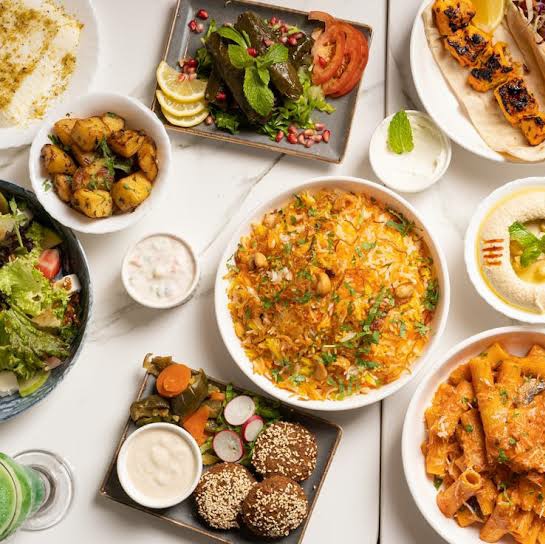In this post, we’ll dive into the top trending cuisine movements of 2025, exploring how chefs, home cooks, and food lovers are embracing new flavors, techniques, and philosophies.
1. Plant-Based Cuisine Goes Global
Plant-based dining isn’t just a health choice anymore, it’s a full-blown culinary revolution. With climate change and sustainability on everyone’s mind, chefs are getting creative with vegetables, legumes, and alternative proteins.
Instead of simply offering vegan versions of meat dishes, many restaurants are developing entirely new dishes built around plants. For instance, jackfruit is being used in curries and tacos, mushrooms are starring as steak alternatives, and lentils are reimagined in gourmet soups and stews.
Countries like India, where vegetarianism has deep cultural roots, are inspiring global chefs to integrate spices, cooking methods, and diverse legumes into modern plant-based cuisine. Even fine dining establishments are now offering multi-course vegan tasting menus.
2. Fusion Food 2.0
Fusion food is not new, but in 2025 it’s making a comeback, and this time, it’s about respectful blending of cultures. Instead of random mashups, chefs are thoughtfully combining flavors and traditions to create dishes that honor both origins.
- Japanese-Italian fusion: miso-infused pasta sauces and sushi-inspired pizzas.
- Mexican-Korean blends: kimchi quesadillas, bulgogi tacos, and gochujang salsas.
- Indian-Mediterranean plates: naan flatbreads topped with hummus and spiced vegetables.
This new wave of fusion cuisine celebrates cultural exchange while keeping authenticity at its core. It reflects the way modern society is becoming more interconnected through travel, migration, and digital communities.
3. Hyperlocal Ingredients and Forgotten Flavors
As globalization spreads, many chefs are going back to their roots, exploring forgotten grains, herbs, and local traditions. Dishes made with ancient grains like millet, sorghum, and amaranth are making a comeback, especially in regions like Africa and India.
- In India, millet-based rotis and porridges are re-emerging thanks to their nutrition and climate resilience.
- In Latin America, quinoa and amaranth are returning as staples, reclaiming their ancient place in the diet.
- In Europe, chefs are reviving wild herbs, roots, and traditional fermentation techniques.
This trend isn’t just about nostalgia, it’s about sustainability, health, and a deeper connection to local food systems.
4. Tech-Enhanced Dining
Technology is reshaping how we experience food. From smart kitchens to AI-driven recipes, dining has entered the digital age.
- AI Recipe Generation: Home cooks are using apps powered by AI to create personalized recipes based on available ingredients.
- 3D Printed Food: Some high-end restaurants are experimenting with 3D-printed pasta, chocolates, and even plant-based meat substitutes.
- Virtual Food Experiences: With VR headsets, food festivals are going digital, allowing people to explore cuisines virtually while chefs livestream cooking experiences.
Even restaurants are using robotic chefs to prepare repetitive dishes while human chefs focus on artistry and creativity.
5. Functional and Wellness-Oriented Foods
Eating in 2025 is not just about taste, it’s about purpose-driven nutrition. People are seeking foods that improve gut health, boost immunity, and enhance overall well-being.
- Fermented foods like kombucha, kefir, and kimchi for gut health.
- Adaptogen-infused dishes, including herbs like ashwagandha and ginseng.
- Protein-rich bowls made with chickpeas, quinoa, tofu, and leafy greens.
6. Street Food with a Gourmet Twist
Street food has always been about accessibility, flavor, and culture. In 2025, street food is going upscale, as Michelin-starred chefs reimagine humble dishes with high-quality ingredients and fine presentation.
- Gourmet pani puri filled with avocado mousse.
- Lobster-stuffed bao buns.
- Truffle-flavored tacos.
This trend keeps the spirit of street food alive while elevating it into unforgettable dining experiences. Cities like Bangkok, Mexico City, and Mumbai remain hotspots for street food lovers, but now you’ll find high-end versions of these dishes in luxury restaurants worldwide.
7. Zero-Waste Cooking and Sustainability
Food waste is a global concern, and chefs are finding innovative ways to make zero-waste cooking mainstream. From root-to-stem cooking (using every part of vegetables) to upcycling “imperfect” produce, sustainability is shaping cuisine trends.
Some restaurants are creating entire menus around rescued food items, while home cooks are learning how to turn leftover bread into puddings or citrus peels into zesty seasonings. This not only reduces waste but also sparks creativity in the kitchen.
8. Rediscovering Regional Cuisines
While globalization introduced us to international dishes, people are now going back to explore regional cuisines within their own countries. For example:
- In India, beyond butter chicken and dosa, people are celebrating Nagaland’s smoked meats, Goa’s Portuguese-inspired flavors, and Rajasthan’s fiery curries.
- In Italy, lesser-known regions like Calabria and Sardinia are being highlighted for their unique pasta styles and seafood traditions.
- In the US, Southern Creole, Appalachian, and Native American foods are gaining recognition.
9. Food as an Experience
Dining in 2025 is not just about what’s on the plate, it’s about the entire experience. Restaurants are creating immersive journeys through themed menus, storytelling, and even theatrical presentations.
For example, a meal may come with augmented reality projections of the farm where the ingredients were grown. Some chefs are pairing food with soundscapes, scents, and visual art, turning dining into a multi-sensory adventure.
10. Home Cooking Renaissance
Finally, thanks to social media platforms like TikTok and Instagram, home cooking has become a global stage. Viral food challenges, quick recipe videos, and DIY gourmet dishes are inspiring people to cook at home more than ever.
From sourdough bread to dalgona coffee, food trends often begin in someone’s kitchen before hitting restaurants. In 2025, expect more community-driven cooking movements, with people exchanging recipes, techniques, and stories across borders.
Conclusion
The world of cuisine in 2025 is an exciting blend of tradition, innovation, and consciousness. From plant-based dining and forgotten grains to AI-driven recipes and gourmet street food, food culture is evolving in fascinating ways.
These trends show us that cuisine is not just about eating, it’s about identity, sustainability, and storytelling. Whether you’re a chef, a traveler, or a home cook, the future of food invites you to experiment, explore, and enjoy flavors like never before.




